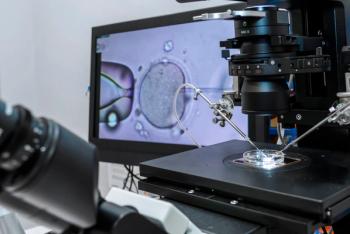
Transvaginal ultrasound predicts cancer risk
Transvaginal ultrasound screening can detect endometrial thickness and other endometrial abnormalities with enough sensitivity to predict a postmenopausal woman's risk for endometrial cancer and atypical endometrial hyperplasia within 1 year of the test, according to study results.
Transvaginal ultrasound screening (TVS) can detect endometrial thickness and other endometrial abnormalities with enough sensitivity to predict a postmenopausal woman's risk for endometrial cancer and atypical endometrial hyperplasia (AEH) within 1 year of the test, according to the results of a large, nested, case-control study from the United Kingdom.
Researchers reviewed data on almost 50,000 postmenopausal women who underwent TVS as part of the United Kingdom Collaborative Trial of Ovarian Cancer Screening (UKCTOCS) after recruitment between April 17, 2001, and September 29, 2005. The researchers noted endometrial thickness and any other endometrial abnormalities and followed the women for about 5 years through national registries and a postal questionnaire.
They found that the optimum endometrial thickness cutoff for endometrial cancer or AEH was 5.15 mm, with a sensitivity of 80.5% (95% Confidence Interval [CI], 72.7–86.8) and a specificity of 86.2% (95% CI, 85.8–86.6). Sensitivity and specificity at a cutoff of 5 mm or greater were 80.5% (95% CI, 72.7–86.8) and 85.7% (95% CI, 85.4–86.2), respectively. When the researchers kept the cutoff at 5 mm or above but added in endometrial abnormalities, the sensitivity and specificity were 85.3% (95% CI, 78.2–90.8) and 80.4% (95% CI, 80.0–80.8), respectively. Increasing the cutoff to 10 mm or greater yielded a sensitivity of 54.1% (95% CI, 45.3–62.8) and a specificity of 97.2% (95% CI, 97.0–97.4). Finally, when the researchers looked at only the women with endometrial cancer or AEH who reported no symptoms of postmenopausal bleeding at the UKCTOCS scan before diagnosis and had an endometrial thickness measurement available, a cutoff of 5 mm yielded a sensitivity of 77.1% (95% CI, 67.8–84.3) and a specificity of 85.8% (95% CI, 85.7–85.9).
Jacobs I, Gentry-Maharaj A, Burnell M, et al. Sensitivity of transvaginal ultrasound screening for endometrial cancer in postmenopausal women: a case-control study within the UKCTOCS cohort. Lancet Oncol. 2011;12(1):38-48.
Newsletter
Get the latest clinical updates, case studies, and expert commentary in obstetric and gynecologic care. Sign up now to stay informed.
















